Day-324 | Daily MCQs | UPSC Prelims | CURRENT DEVELOPMENTS
[WpProQuiz 369]
[WpProQuiz 369]
THE CONTEXT: The Union government has a noble objective of doubling farmer income by 2022 Thus the Indian agriculture sector has been witnessing a slew of reforms especially on corporate and contract farming. Against this backdrop, this article comprehensively discusses the issues of corporate and contract farming by adopting an in-depth approach.
UNDERSTANDING CORPORATE FARMING
UNDERSTANDING CONTRACT FARMING
ADVANTAGES
DISADVANTAGES
ADVANTAGES
DISADVANTAGES
CORPORATE FARMING
CONTRACT FARMING
CORPORATE FARMING
DOMESTIC
INTERNATIONAL
CONTRACT FARMING
DOMESTIC
INTERNATIONAL
CORPORATE FARMING
CONTRACT FARMING
CRUCIAL ROLE OF GOVERNMENT
ADDRESSING ISSUES OF DOMINATION
ENSURING FOOD SECURITY
ADDRESSING ENVIRONMENTAL CONCERNS
PROTECTING AGRICULTURAL DIVERSITY
INTRODUCING POLICY CLARITY
PARTNERSHIP WITH STATES
CONCLUSION: The need for greater involvement of private players in the agriculture sector is a foregone conclusion. But the debate is about the manner and the extent of the participation. In the quest for greater capital formation and improved agriculture production and productivity, the dysfunctional aspects of corporate and contract farming must not be neglected. A comprehensive policy regime rooted in the ethos of “the last man on the street” formulated through wide-ranging and effective participation of all relevant stakeholders can take agriculture to new heights in India.
THE CONTEXT: According to a study by the pharmaceutical company, the Roche’s Alzheimer’s drug candidate could not be shown to slow dementia progression in two drug trials.
THE EXPLANATION:
The study
VALUE ADDITION:
Alzheimer’s Disease:
Caused by: Alzheimer’s disease is thought to be caused by the abnormal build-up of proteins in and around brain cells.
Vulnerability: Alzheimer disease most commonly affects older adults, but it can also affect people in their 30s or 40s.
Cases:
THE CONTEXT: The United Nations recently revealed that the world population has reached 8 billion mark. India is the largest contributor to the milestone, having added 177 million people.
THE EXPLANATION:
Good record
THE CONTEXT: The AEAN members agreed in principle to admit East Timor as the 11th member of the bloc.
THE EXPLANATION:
What is ASEAN?
The Association of Southeast Asian Nations (ASEAN) is a regional bloc founded on August 8, 1967 in Bangkok, Thailand. Its member states are Brunei, Cambodia, Indonesia, Laos, Malaysia, Myanmar, the Philippines, Singapore, Thailand, and Vietnam. East Timor was added as a new member of this regional grouping.
About East Timor
East Timor and ASEAN
East Timor started applying for ASEAN membership in 2011. The ASEAN decided to admit the island nation as its 11th member more than a decade after Timor-Leste requested membership. This decision was made at Cambodia’s capital, Phnom Penh, where the 40th and 41st ASEAN and related summits officially began recently. East Timor was granted observer status at ASEAN meetings, including summit plenaries, until it is formally inducted into the regional bloc.
THE CONTEXT: Vice President recently addressed the East Asia Summit on the last day of his visit to Cambodia, as the three-day Association of South East Asian Nations (ASEAN) summit concluded.
THE EXPLANATION:
What is the East Asia Summit?
What are the EAS’s links with India?
THE CONTEXT: The Global Shield Against Climate Risks initiative was launched on November 14, 2022 by the Vulnerable Twenty (V20) countries and G7 countries. While V20 countries represent 58 countries that are vulnerable to climate change, the G7 represent seven of the world’s most industrialized countries.
THE EXPLANATION:
About the initiative
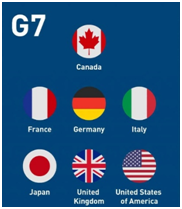 (COP27) to the United Nations Framework Convention on Climate Change in Sharm El-Sheikh, Egypt.
(COP27) to the United Nations Framework Convention on Climate Change in Sharm El-Sheikh, Egypt.How will the initiative be implemented?
THE CONTEXT: India’s national grid operator Power System Operation Corporation Limited (POSOCO) was renamed as Grid Controller of India Limited.
THE EXPLANATION:
About Grid Controller of India Limited (Grid-India)
Why was the name changed?
Q1. Consider the following statements about Atal Tunnel:
1. It is located near Baralacha La pass in Himachal Pradesh.
2. It provides all weather connectivity from Manali to Lahaul and Spiti valley.
Which of the statements given above is/are correct?
a) 1 only
b) 2 only
c) Both 1 and 2
d) Neither 1 nor 2
Answer: B
Atal Tunnel:
POLITY AND GOVERNANCE
SOCIAL ISSUES
INTERNATIONAL ISSUES
ECONOMIC DEVELOPMENT
ENVIRONMENT AND ECOLOGY
ETHICS EXAMPLES AND CASE STUDY
QUOTATIONS AND CAPTIONS
50-WORD TALK
Things to Remember:
[WpProQuiz 368]
THE CONTEXT: Recently the Government of India has passed three farm bills that are being widely criticised by many farmer organisations. The farm bills are criticised for being pro market reforms that has the potential of harming farmer’s interest in the long run.
The three farm acts:
1.Farmer’s Produce Trade and Commerce (Promotion and Facilitation) Act, 2020
2. Farmers (Empowerment and Protection) Agreement of Price Assurance and Farm Services Act, 2020
3. Essential Commodities (Amendment) Act, 2020
The purpose of the new farm laws is to end the historic exploitation of farmers at the APMC markets and free them from the clutches of the middlemen.Farmers who sell their produce to mandi merchants, or ‘arhatiyas’, at agricultural produce market committee (APMC) markets still receive informal white slips with the transaction amount scribbled on them, making the record non-transparent.The purpose of the new farm laws is to end the historic exploitation of farmers at the APMC markets and free them from the clutches of the middlemen.
1. Economic history of exploitation at mandis
2. Inefficiencies in APMCs
3. Widened markets benefit farmers
4. Infringement of rights
5. No interference with state
6. Multiple markets and competition
7. Bihar’s impressive performance
8. Contract farming
9. Agriculture markets starved of 3Cs
10. National overseeing authority
WAY FORWARD
Three fundamental reforms are necessary to make India’s growth more just and more inclusive.
CONCLUSION:
THE CONTEXT: Recently, the Supreme Court agreed to hear a petition challenging the 1st Constitutional amendment’s expansion of restrictions on the freedom of speech and expression (Article 19(1)(a)) on the grounds that the amendment violates the basic structure doctrine.
THE EXPLANATION:
Article 19 of the Indian Constitution: Protection of certain rights regarding freedom of speech, etc.
Rights enlisted under Article 19 (1): All citizens shall have the right –
(a) to freedom of speech and expression;
(b) to assemble peaceably and without arms;
(c) to form associations or unions;
(d) to move freely throughout the territory of India;
(e) to reside and settle in any part of the territory of India;
(g) to practise any profession, or to carry on any occupation, trade or business.
Reasonable restrictions are imposed on Article 19(1)(a) in 19(2): In the interests of
The 1st amendment to the Indian Constitution:
Background:
About the Constitution (First Amendment), Act 1951:
The basic structure doctrine:
Background:
THE CONTEXT: Heads of state and governments belonging to 20 of the world’s major advanced and emerging economies have gathered for a two-day summit meeting in Bali, Indonesia.
THE EXPLANATION:
The Bali summit will have three key priorities:
1. Global Health Architecture: This involves deliberations towards strengthening global health resilience and making the global health system more inclusive, equitable, and responsive to crises.
2. Digital Transformation: Deliberations here have centred on achieving the full potential of rapid digitalisation of the global economy by creating a new landscape of cooperation among nations.
3. Sustainable Energy Transition: The discussions have focussed on ways to accelerate the transition towards cleaner energy sources.
In particular, since any such transition requires substantial investments, the efforts have been focussed on finding a platform for such investments.
What else is at stake?
THE CONTEXT: According to a study published in the journal Ecological Informatics, certain mangrove species in Chilika and Sundarbans along the east coast and Dwarka and Porbandar along the west coast of India is likely to reduce and shift landward by 2070 due to decline in suitable habitats in response to precipitation and sea level changes.
THE EXPLANATION:
Value Addition:
Mangroves in India
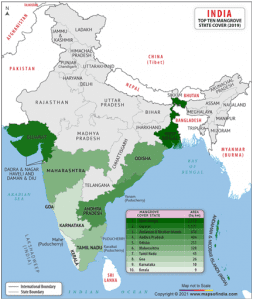
THE CONTEXT: India recently submitted its Long-Term Low Emission Development Strategy to the United Nations Framework Convention on Climate Change (UNFCCC), during the 27th Conference of Parties (COP27).
THE EXPLANATION:
The salient features of the strategy are:
India’s approach is based on the following four key considerations that underpin its long-term low-carbon development strategy:
The two themes of “climate justice” and “sustainable lifestyles”, alongside the principles of Equity and Common But Differentiated Responsibilities and Respective Capabilities (CBDR-RC), in the light of national circumstances, that India had emphasized at Paris, are at the heart of a low-carbon, low-emissions future.
THE CONTEXT: Recently, India announced its long-term strategy to transition to a “low emissions” pathway at the United Nations Conference of Parties (COP) ongoing in Sharm el-Sheikh, Egypt.
THE EXPLANATION:
LT-LEDS (Long Term-Low Emission Development Strategy):
India’s LT-LEDS includes
Mode of Transportation –
India also aims for a “strong shift” to public transport for passenger and freight traffic.
Carbon Sequestration –
On Climate Finance –
VALUE ADDITION:
About COP27:
THE CONTEXT: According to Indian Navy, as many as 392 reported incidents of illegal, unreported and unregulated fishing were monitored in 2021 compared to 379 in 2020 in the Indian Ocean.
THE EXPLANATION:
IUU fishing:
IUU fishing depletes fish stocks, destroys marine habitats, puts fishermen at disadvantage and impacts coastal communities, especially in developing countries.
Information Management and Analysis Centre (IMAC):
Regional fisheries management organisations:
Global Regulations:
There are two main regulations globally on IUU fishing:
1. the Cape Town Agreement and
2. the Agreement on Ports State Measures.
Q1. Dover strait connects which of the following water bodies?
a) North Sea and Baltic Sea
b) English channel and North Sea
c) Atlantic Ocean and Mediterranean Sea
d) Mediterranean Sea and Black Sea
Answer: B
Explanation:
Please refer to the map-
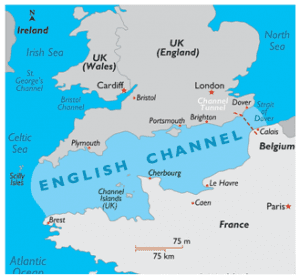
[WpProQuiz 367]
THE CONTEXT: The recent farmer agitation has brought the issue of farmer distress front and centre in the public consciousness. The time seems ripe to find new solutions to the structural challenges facing farmers. One of the solution is to support farmers by Direct Income Support (DIS) but in recent time several reports highlighted that such schemes are facing many challenges. In this article, we will discuss that what should be the way forward for the effective implementation of these scheme.
Initially, the scheme was targeted at small and medium landed farmers, but with the declining growth in gross value added of the agricultural sector, it was extended to all farmers in May 2019.
Features of the scheme:
Direct Income Supports’ ability to encourage farmers to raise production is less. At the same time, it has some positives:
The PM KISAN scheme has completed two years (seven installments are released of the scheme) but facing several crises. The scheme is a useful vehicle to provide support to farmers and it was included in the Pradhan Mantri Garib Kalyan Package during lockdown but, was this a useful way of relieving distress during the lockdown? A survey by NCAER National Data Innovation Centre in June 2020 provides some useful insights in this regard:
Findings of the survey
Performance of PM-KISAN during the Pandemic
Lack of DataBase
Difficulty in Identifying Beneficiary Farmers
Census Issue
Others
WHAT SHOULD BE THE WAY FORWARD?
Proactive role of Banks
Strengthening IT backbone
Targeting benefits and updation of land records
CONCLUSION: PM- KISAN is India’s first direct support scheme, which should be surely successful. But for this, govt of India should learn some important lessons from other sources like the KALIA scheme and for that technology can play a vital role. The potential of technology to transform social welfare delivery is exciting. An approach that leverages data to maximize citizen benefits, while ensuring privacy, security and access, must be the way forward if we are to truly realize the power of digital to serve every Indian.
JUST ADD TO YOUR KNOWLEDGE
THE MSP AS A PRICE SUPPORT MEASURE
PM-KISAN (DIRECT INCOME SUPPORT)
THE CONTEXT: The 3rd Ministerial “No Money for Terror” Conference will set to be held on November 18 and 19 this year in New Delhi, India.
THE EXPLANATION:
What is the NMFT conference?
3rd Ministerial ‘No Money for Terror’ Conference
What are the focus areas of the 3rd NMFT conference?
THE CONTEXT: The Indian Government issued notification on E-Waste (Management) Rules, 2022, which will come to effect from next financial year.
THE EXPLANATION:
What is E-Waste (Management) Rules, 2022?
What are the key features of the rules?
THE CONTEXT: The Global Climate Budget 2022, released at The 2022 United Nations Climate Change Conference or COP27, indicates that India will record a higher rise in carbon emissions this year than other major countries.
THE EXPLANATION:
What are the key findings of the Global Carbon Budget, 2022?
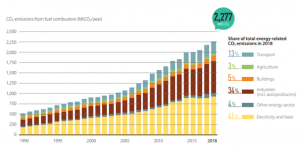
THE CONTEXT: The Government of India has approved the issuance of the 23rd tranche of electoral bonds for sale from November 9-15 following an amendment.
THE EXPLANATION:
What are the changes made in the scheme?
Value Addition:
What are electoral bonds?
THE CONTEXT: Recently, the BHIM App open-source license model was announced by the National Payments Corporation of India (NPCI).
THE EXPLANATION:
What is BHIM App open-source license model?
Why was open-source license model launched?
What is Unified Payments Interface (UPI)?
VALUE ADDITION:
National Payments Corporation of India (NPCI)
THE CONTEXT: Union Minister of state for Science and Technology recently dedicated Indian Biological Data Center (IBDC) to the nation.
THE EXPLANATION:
What are its objectives?
The objectives of IBDC are:
1. Provide IT platform for archiving of biological data originating from India.
2. Develop standard operating procedures for storing and sharing of life sciences data based on FAIR (Findable, Accessible, Interoperable and Reusable) principle.
3. Perform quality control and curation of data, maintain data backup and manage data life cycle.
4. Develop web-based tools/APIs for data sharing or retrieval
5. Organize training programme for analysing of large data and create awareness about the benefits of data sharing.
What are the current tasks of the IBDC?
POLITY AND GOVERNANCE
SOCIAL ISSUES
INTERNATIONAL ISSUES
ECONOMIC DEVELOPMENT
ENVIRONMENT AND ECOLOGY
ETHICS EXAMPLES AND CASE STUDY
QUOTATIONS AND CAPTIONS
50-WORD TALK
Things to Remember:
[WpProQuiz 366]
[WpProQuiz 365]
THE CONTEXT: In June 2021, the Group of Seven (G7) major developed economies held their first in-person summit since 2019 in Cornwall, UK. The discussion focused on addressing the Covid-19 crisis, climate change, global taxation, etc. This article analyses the tax-related outcome in detail.
The G7 proposal
WHY THE MOVE
LOSS DUE TO PRESENT RULING
RESENT TAX RATES
WHAT WILL CHANGE AFTER NEW TAX SLABS?
SOVEREIGN ISSUE
INVESTMENT
TAX COLLECTION REDUCTION
DATE OF SUMMIT
11-13 June 2021
PARTICIPATION
MAJOR OUTCOMES OF THE SUMMIT
INDIA AT THE SUMMIT
PM took part in two sessions of Summit: ‘Building Back Together—Open Societies and Economies’ and ‘Building Back Greener: Climate and Nature’.
Highlights of PM speech
ON COVID AND VACCINATION
Positives
Negatives
G7 ignores the three immediate actions recommended
G7 falls short significantly on all three counts.
ON CLIMATE
ON CHINA
A TEMPLATE FOR INDIAN ENGAGEMENT WITH THE WEST
ON CLIMATE
FAIRTRADE AND FREE TRADE
WAY FORWARD:
CONCLUSION: India’s engagement with the west and the recent tax proposal by G7 is the opportunity for India to overcome the challenge that occurred after Covid-19. Although, India’s concerns are justified, surely, the global minimum tax would be a game-changer for countries like India. The proposal indicates a political momentum and a desire to fast-track structural taxation reforms that could improve India’s economic competitiveness and lower jurisdictional tax arbitrage.
THE CONTEXT: Recently, the Solicitor-General at the Human Rights Council (HRC) in Geneva stated that India appreciates the role of human rights defenders, journalists and activists in the democratic system but the activities of these groups and individuals should be in conformity with the law of the land.
THE EXPLANATION:
Starting the fourth cycle of the Universal Periodic Review of India at the HRC, Greece, the Netherlands and Vatican City called upon the Government of India to ensure freedom of religion and end discrimination against human rights defenders and religious minorities.
HIGHLIGHTS OF THE MEETING:
Connect the Dots: FCRA, Vasudhaiva kutumbakam , National Register of Citizenship
VALUE ADDITION:
United Nations Human Rights Council
Functions:
Tenure:
THE CONTEXT: Amid the 27th Session of Conference of Parties (COP27), this year’s UN climate summit, the Mangrove Alliance for Climate (MAC) was launched with India as a partner.
THE EXPLANATION:
The MAC
The significance of mangroves
The current state of the mangroves
THE CONTEXT: Recently the UN Secretary-General set up an expert group solely to look into Greenwashing as a practice is prevalent enough to create concerns over climate goals that were completely undermined and was considered as serious.
THE EXPLANATION:
What is greenwashing?

THE CONTEXT: Developing countries, including India, are pushing rich countries to agree to a new global climate finance target—also known as the new collective quantified goal on climate finance (NCQG)—which they say should be in trillions as the costs of addressing and adapting to climate change have grown.
THE EXPLANATION:
VALUE ADDITION:
Nationally Determined Contributions (NDCs): The Paris Agreement and NDCs
THE CONTEXT: Recently Russia’s Defence Minister announced the withdrawal of the troops from Kherson to a new defensive line on the eastern bank of the Dnipro river.
THE EXPLANATION:
Where is Kherson and why is it important?
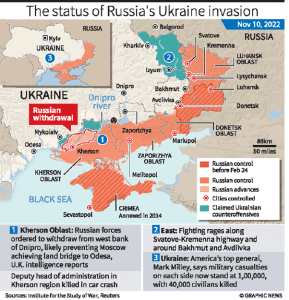
How did Kherson come under Russia’s control?
Why has Moscow announced its withdrawal from Kherson?
THE RIVER: DNIEPER
The Dnieper or Dnipro is one of the major transboundary rivers of Europe, rising in the Valdai Hills near Smolensk, Russia, before flowing through Belarus and Ukraine to the Black Sea. It is the longest river of Ukraine and Belarus and the fourth-longest river in Europe, after the Volga, Danube, and Ural rivers.

THE CONTEXT: Armistice Day, also known as Remembrance Day or Poppy Day. It is marked on 11 November annually, remembering those who died in World War I. Marking the end of the Great War.
THE EXPLANATION:
Why does Poppy hold significance?
How is the day observed?